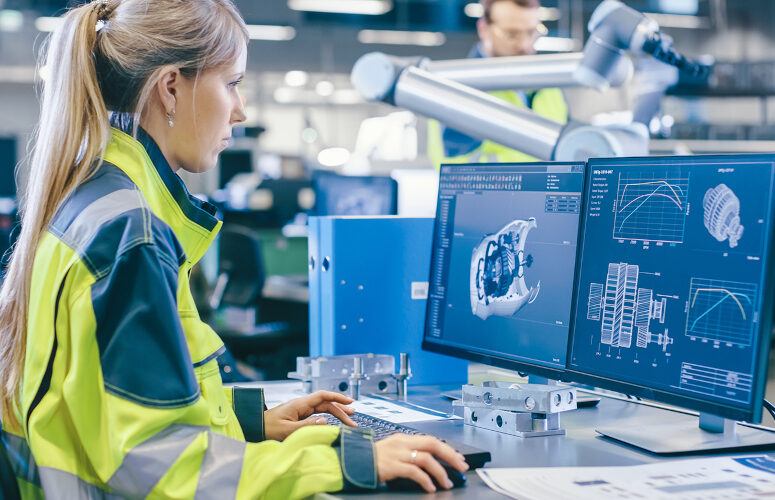
Today’s Manufacturing: Not Your Grandfather’s Widget Factory
By Paul K. Steck , President, Exothermic Molding, Inc. On Sep 19, 2022The Way We Were
Back in the day, manufacturing had the reputation of being a “dirty” industry known for poor working conditions, low pay, lack of opportunity, and overall, low prestige. In short, unless you were the owner, nobody aspired to it as a career choice. It was simply a means to an end—a job that put food on the table and paid the rent. Much was written about the downside of the industry—novels like Upton Sinclair’s The Jungle depicted the exploitation of immigrants.
However, the very face of manufacturing changed dramatically during the 20th century. But not until the nearly cataclysmic changes of the 21st century did the industry morph into an entirely different category of business. So, what changed?
The Way We Are Today
Today’s manufacturing is often clean—sometimes to an extreme. Witness the pharmaceutical clean rooms where the most critical level of cleanliness is achieved. Many of today’s manufacturing plants offer spacious, well lighted, well ventilated, low noise environments. Their physical plants have undergone a drastic makeover. They are pleasant places to work. Many are eco-friendly facilities striving to reduce their carbon footprint. They often use eco-friendly materials and processes, as well as producing environmentally friendly products.
Without question, today’s manufacturing is no longer just nuts and bolts and heavy machinery. It is hi-tech in every sense of the word. Manufacturing runs on technology in a big way. Many of the systems are automated; many of the processes require technical knowledge, and the digital era is having a marked effect on how manufacturing is moving to the future:
This year, factories and manufacturing are trending rapidly towards smart factory adoption, advancing from occasional implementation of smart equipment to complete facility systems using data analytics and communication between machinery. As newer machinery finds its way into facilities, it comes equipped with digital pathways using technology to work at greater efficiency and efficacy; better active maintenance, greater process efficiency, and reduced operating costs. Many businesses are already enjoying these benefits with others rushing to keep up with their competition as smart factory hardware and software costs continue to drop.
Supply chain disruptions of the past have created a new-found recognition of how important maintaining optimized functionality without interruptions is for all sized businesses. The supply chain will hold a prominent requirement for continual improvement in years to come. The digital toolkit for monitoring and improving is becoming paramount in efforts to analyze and manage supply chain effectiveness. with facilities seeking creative ways to add litheness and reliability while also retaining value. Data analysis is being used to adjust to any unpredictability in the chain allowing for greater adaptation towards minimalizing interruption and in the end assuring steadiness and fulfillment.
AI Technologies are developing into a key resource helping manufacturers monitor operations remotely. This provides both 24-hour access to machining for long projects, as well as greater safety for operators.
Manufacturing companies must be more efficient and defter than ever to gap and labor shortages, providing front-line technical training to meet demands. Technical know-how is provided by manufacturers through custom-developed training programs (both legacy and digital) and apprenticeships, some of which are subsidized by the government. As a result of skills training, advancement opportunities increase. Providing career paths is one of the best ways to entice employees to work for a manufacturing company. Though they may start at lower levels of pay, they have a pathway to growth that other lower-paying jobs lack. Many families and individuals have been able to thrive in this welcoming community.
Manufacturing companies of today are progressive enterprises on the cutting edge of more than just technology. Their efforts contribute to building a better workforce that can contribute more to the American economy. In today’s manufacturing industry, companies are often socially conscious and leaders in their communities. Many times, the company is among the first to support local charities. Younger workers are discovering that joining the manufacturing community offers a chance to make an impact. Perhaps a small component they manufacture ends up in a space launch – or perhaps in a hospital or rehabilitation facility, helping a disabled veteran walk again. They may create a medical diagnostic tool that could save lives.
That is today’s manufacturing. It’s principle-centered, progressive, ever-evolving, and has heart.
About the Author: Paul K. Steck is the President of Exothermic Molding, Inc.in Kenilworth, NJ, a third-generation family-owned plastics molding firm serving a variety of industries. Visit: www.exothermic.com.
To access more business news, visit NJB News Now.
Related Articles:





